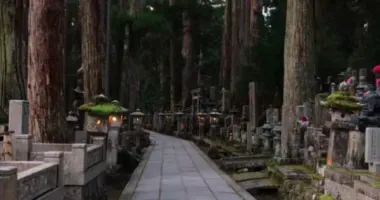Okunoin 奥の院
- Published on : 13/10/2014
- by : R.Z.
- Youtube
Spirit, are you there?
In the most popular Japanese cemetery along a driveway of rustling woods, encounters with souls of long ago surprise those who are not careful.
According to the superstition of the Shingon Buddhist school, there are no dead in Okunoin, but only waiting spirits. As the story is told, one day Kukai (774-835), better known in Japan under the name of Kobo Daishi, the founder of the religious community of Mount Koya, came out of meditation upon the arrival of Miroku, the Buddha of the future.
So all the souls in transit resting in the graves or of whom the hair or ashes had been placed by their loved ones in front of the Kukai Mausoleum, also rose up. Pending the advent of this apocalyptic prophecy, the number of graves in Okunoin continues to increase and already counts more than two hundred thousand and is the largest cemetery in the archipelago.
A glimpse of the afterlife
Cross the Ichi Hashi no bridge, which opens the way to Okunoin is like crossing a bridge between two worlds. Just before, the faithful join hands and bow to show their respect to Kukai.
On the other side, the atmosphere is different, the air is charged with the sacred. The dizzying cedars that dot the first graves hide the sky and the end of the paved road that runs up through the wood. The styles of the burial memorials vary too much for the eye to dwell on each of them, but the most spectacular cenotaphs attract attention, such as the one an insecticide company dedicated to its termite victims.
Leaving the main path and venturing amid forgotten tombs with eroded stone or covered with moss, allows you to realize that here, Nature has reclaimed its rights. Conversely, the secondary entrance of the cemetery, located across from the Okunoin-mae bus stop, leads to the more recent tombs made with refined granite, as if varnished, artificial, taking away all individuality from their eternal residents. Another sign of modernity, the offerings themselves have changed and soda cans have joined incense and sutras (words attributed to the Buddha or his immediate disciples).
Along the main path, do not be surprised by the accessories worn by the statues of Buddhas, who often have a vermilion bib. The are offerings that mothers leave to protect their children in this world or to bring them luck in the afterlife.
The tension mounts
Following the path to the north, after crossing the bridge in the middle, Naka no Hashi, another Gobyo no Hashi, announced the passage into a more advanced level of the sacred. The walkway, of which the thirty-six boards are engraved on the back with Buddhist deities, is itself considered as such. It is necessary to, once again, to bowing with your hand together to invoke Kûkai /admin/articles/edit/1555before going across.
The area you come to requires the utmost respect. Food, drinks and photographs are not allowed. A little further, on the left, a wooden cabin houses the Miroku stone, which, when lifted weighs the sins of the person. Through small gaps in the walls, it is possible to access the stone and it is customary to try to lift it with one hand to place high up on a shelf.
Once you have completed this test, the Toro-do emerges through the trees. This Lantern pavilion houses hundreds of luminous wonders, some of which, according to legend, have been burning unabated for over nine hundred years! A flame in the depths of the night, it is the last building before the holy heart of the cemetery, the ultimate pilgrimage that justifies coming this far into the forest for many devout believers, the eternal dwelling of Kukai.
"The innermost sanctum"
The Okunoin, which is the literal meaning, is above all a place of contemplation. The thousands of graves are eclipsed! By this single sepulcher, which is however inaccessible to ordinary mortals. The Gobyo is said to house the famous Kobo Daishi, who continues to meditate, without a sigh. Each day, meals are deposited at the door in support of his effort, while monks and laymen reflect in silence and recite sutras in a low voice. Everyone is free to respresent the venerable one in his cramped interior. Whatever happens, the doors remain closed.
Day and night, braving clouds of mosquitoes in summer or gloomy foggy days, visitors flock in all weather to Okunoin, especially on Obon day, when Rôsoku matsuri takes place and the monks of Koyasan light thousands of candles along the paths. One day is not enough to grasp the its extent and many lives would be necessary to discover all its secrets. Despite this, strangely for a cemetary, its tranquility soothes the souls of through it. Probably because, impassive in his retreat, Kukai is watching over them.

























